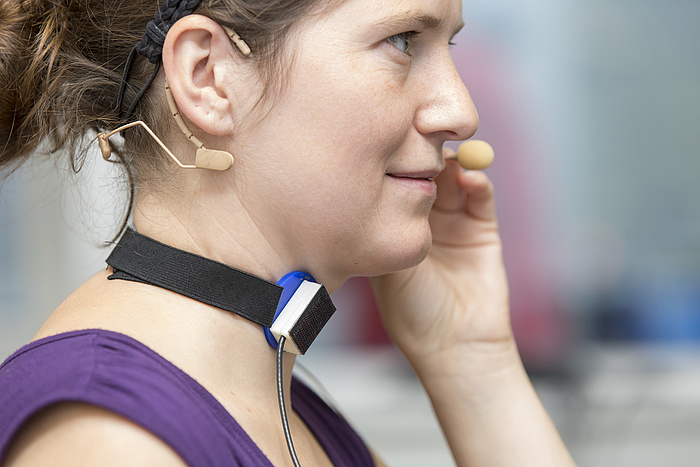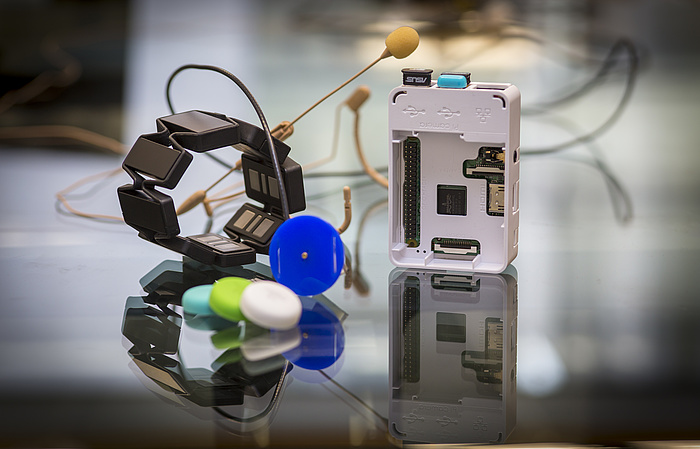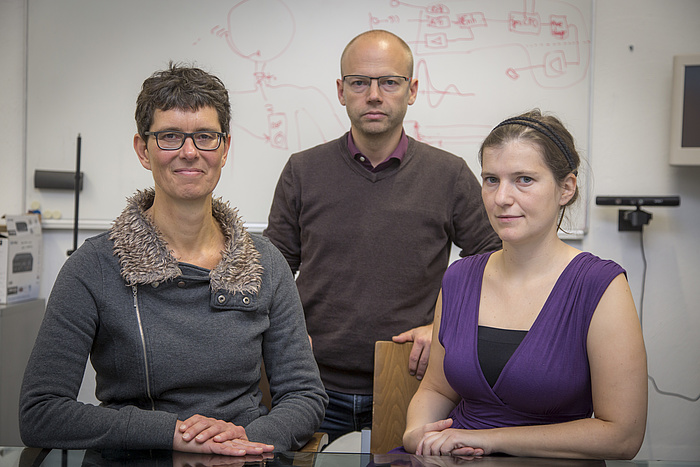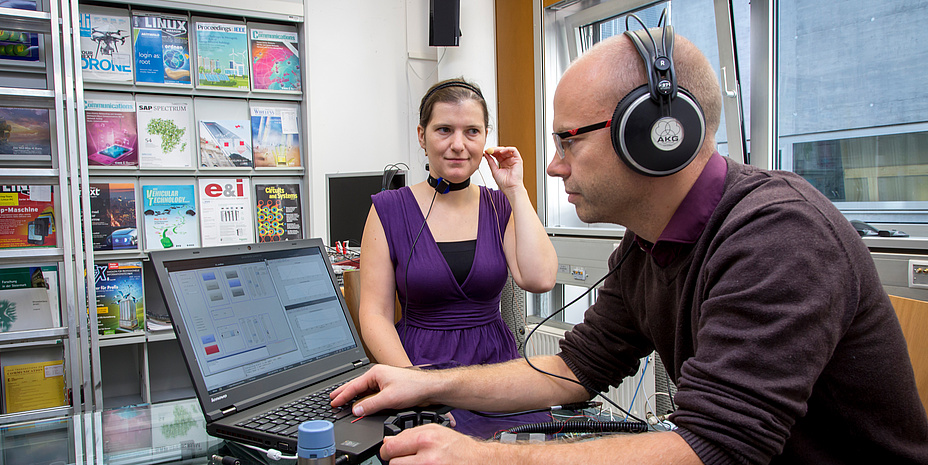The diagnosis comes as a deep shock for the person. A loss of the larynx, for instance due to cancer, changes a person’s everyday life quite fundamentally. The larynx contains not only all the vocal chords, it also acts as a switch point between the oesophagus and the trachea, or windpipe – every time we swallow, it closes the passage to the trachea. While we normally take this function for granted, it does not work any more if you need a “tracheostoma” – an artificial breathing hole into the trachea through the throat – because in this case the pharynx, instead of being connected to the trachea, goes directly into the oesophagus. This is why the loss of the vocal chords automatically means that you lose your speech. You cannot hear words spoken by the person any more. In the Germanspeaking area, about 25,000 persons have lost their larynx – approximately 3,000 laryngectomies are performed every year in Germany.
HumanEVoice
Technical devices can enable patients to recover their ability to speak. Electronic speaking aids and the speech they generate are among the research interests of the<link https: www.spsc.tugraz.at _blank int-link-external external link in new> Institute of Signal Processing and Speech Communication at Graz University of Technology. The “HumanEVoice” project, in which <link https: online.tugraz.at tug_online _blank int-link-external external link in new>Anna Katharina Fuchs and <link https: online.tugraz.at tug_online _blank int-link-external external link in new>Martin Hagmüller are involved in a leading role at Graz University of Technology, strives to find ways of producing speech with a more personal touch.

The HumanEVoice projects aims at providing a more natural voice for people who have lost their vocal cords.
“There are three ways how a person without a larynx can recover speech,” explains Martin Hagmüller. “The first is to swallow air and then execute carefully controlled burps.” Although this may sound scurrilous, it truly is one of the possibilities of replacing the vocal chords. However, the relevant preparations must be made already at the time when the surgery is performed. “It is difficult to learn this technique,” says Hagmüller. “Another variant is to introduce a valve between the trachea and the oesophagus.” If you cover the trachaeostoma with a finger, the valve lets air flow into the mouth, thus facilitating speech. At present this is the standard solution. But this variant is also expensive: the valve is error-prone and has to be changed every two months. The third possibility is to imitate the function of the vocal chords through external vibrations – using an electronic “voice box”.
Electronic speech aids
Basically this is a small vibrating device that is held against the throat. Its function is to make the movements of the mouth audible when you speak. Although this technology has been around since the 1960s, it has remained largely unchanged since then. A handful of research groups are researching improvements at various international universities, for example in Japan in Nara near Osaka where Anna Katharina Fuchs stayed as a guest student during her doctoral thesis. One problem of the currently available devices is that they only generate one particular frequency. As a result, the generated speech sounds monotonous and unnatural. In Nara the researchers are now trying to use a variable frequency to produce a more natural intonation. “My stay in Japan was very inspiring,” says Fuchs who investigated an algorithm to automatically vary the melody of speech in Nara. “However, they only conduct research in this one area, there is no overall package.” The same also applies to all other international research projects.

The MYO bracelet allows the electronic speech aid to be controlled.
But Fuchs and Hagmüller intend precisely to create such an overall package. For this purpose, they are combining new approaches from different areas, from special waveforms that are better able to penetrate the throat tissue and various pitchmodulating methods to miniaturisation and new wearing varieties to develop a device that unites all the advantages.
Surprising criticism
“Ultimately the key is to speak to the user directly,” says Fuchs. When she did, she made some surprising discoveries. “Existing systems were most frequently criticised for not being loud enough. If there is any other noise nearby, for example if several people speak at the same time, they can hardly be heard at all.” Another problem is that current devices must be held in the hand although in daily life it is often necessary to have both hands free, for example when you are eating, or driving a car. Furthermore, the devices should be more inconspicuous because the users of an electrolarynx often feel stigmatised. An alternative is a device fitted to a collar that can ideally be switched on and off automatically.
Natural speech melody
The pitch of the artificially produced voice is also a problem. Fuchs explains that “the output of most currently available voice boxes tends to sound male – if they sound human at all. Gender research is entirely new in this field. Together with Corinna Bath we want to look at the entire bandwidth of genderspecific differences, beyond the stereotypes.” According to the researchers, this diversity aspect leads to a welcome widening of the horizon. In their quest to create a natural speech melody, Fuchs and Hagmüller are cooperating primarily with Corinna Bath from the Technical University of Braunschweig. She currently holds a visiting professorship as an expert at the interface between gender research and technology at TU Graz. Fuchs and Hagmüller are currently using a simulation environment in which they can try out various things in real time. With the sponsorship of the FEMtech programme of the Austrian Research Promotion Agency (FFG) and the support of partner HEIMOMED, a German company specialised in the manufacture of products for persons without a larynx, their work attempts to combine different approaches in order to facilitate the development of new electrolarynxes.

Expert on Gender Corinna Bath and the team of TU Graz Martin Hagmüller and Anna Katharina Fuchs.
This research area is anchored in the Field of Expertise „Information, Communication & Computing“, one of five research foci of TU Graz.
Martin HAGMÜLLER
Dipl.-Ing. Dr.techn.
Institute of Signal Processing and Speech Communication
Inffeldgasse 16c
8010 Graz
Phone: +43 316 873 4377
<link int-link-mail window for sending>hagmueller@tugraz.at







